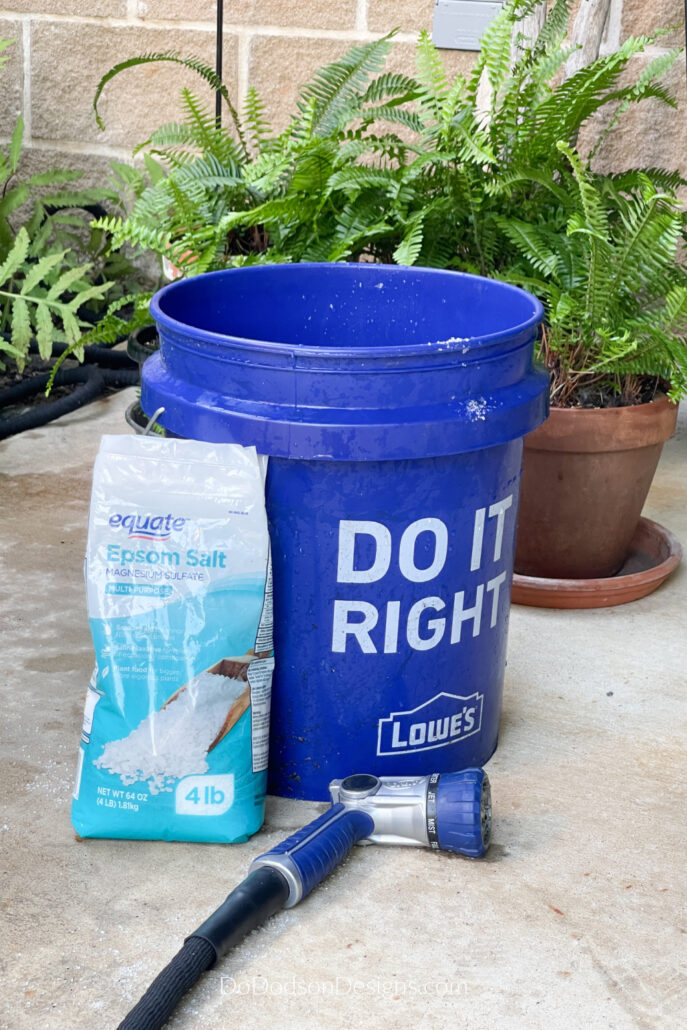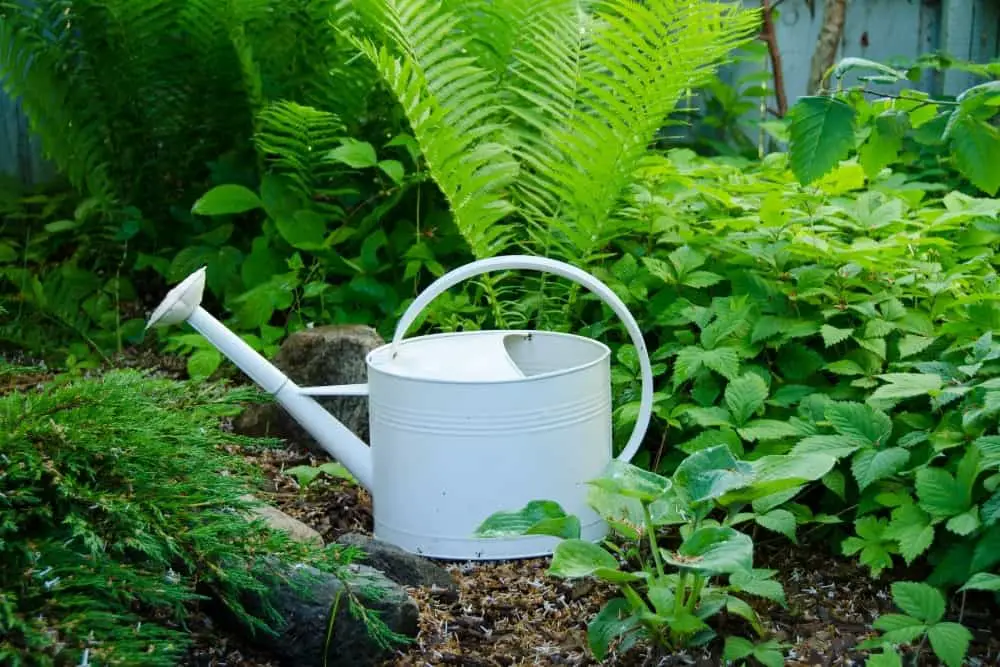Hey triple-D friends! I’m back in the garden! If you like ferns, you know they’re pretty fragile plants that need special care. What would you say if I told you I found something that will make your ferns grow better? It’s a quirky way to help ferns outside. Not only is it simple to do, but the benefits are impressive.
* As an Amazon Associate, I earn from qualifying purchases and through other companies as well. You won’t be charged extra if you buy something through one of these affiliate links, but any money I make helps me make more fun DIY projects to show you! Click here to read my full disclaimer.
Ferns are beautiful, delicate plants that can add graceful fronds and lush greenery to your outdoor spaces However, caring for ferns requires paying special attention to their watering needs. Learning how to water outdoor ferns properly is essential to keeping them healthy, vibrant, and thriving in your garden
In this comprehensive guide, we will cover everything you need to know about watering outdoor ferns, including:
- Understanding ferns’ preferences for consistent moisture
- Watering frequency guidance for ferns in pots vs. in-ground
- The best time of day to water ferns
- Using room temperature water for watering
- Techniques for effective watering (at the base, soaking, etc.)
- Signs that your ferns need more or less water
- Tips to avoid overwatering and its consequences
Follow these tips and you’ll be rewarded with happy, lush ferns that add beauty to your outdoor living spaces.
Why Consistent Moisture is Key for Fern Health
Ferns thrive in humid moist environments reminiscent of the shady forest floors and rainforests where they naturally grow. Their delicate fronds and shallow roots require frequent access to water. Consistently moist (but not soggy) soil is ideal for fern health and growth.
When ferns don’t get enough water, their fronds turn yellow or brown and the plant becomes stressed. On the other hand, overwatering can lead to root rot. That’s why paying close attention to soil moisture and watering correctly is so important.
How Often to Water Potted vs. In-Ground Ferns
How often you’ll need to water your outdoor ferns depends on whether they are potted or planted in the ground:
-
Potted ferns – Check soil moisture daily. Water potted ferns whenever the top 1-2 inches of soil becomes dry. Pots dry out more quickly than in-ground plantings.
-
In-ground ferns – Water in-ground plantings 2-3 times per week. Pay attention to soil moisture and local weather when determining watering frequency.
Other factors like sunlight exposure, humidity, temperature, soil type, and plant size can also affect watering frequency. Get to know your ferns’ needs by observing them closely.
Water Ferns in the Early Morning
The ideal time to water ferns is in the early morning hours. Avoid watering in the heat of the day or evening:
-
Morning watering allows the fern fronds to dry off faster in the sun’s warmth. Wet foliage at night can lead to disease.
-
Less water is lost to evaporation when you water early in the day.
Aim to water first thing in the morning so your ferns benefit from a full day of hydration. Adjust timing as needed based on your climate and schedule.
Use Room Temperature Water for Fern Watering
Your ferns will appreciate watering with water that’s neither too cold nor too hot. Using room temperature water prevents temperature shock and stress:
-
Cold water straight from a hose or watering can could damage the fern’s delicate fronds and roots.
-
Hot water risks burning the plant.
Before watering, allow water from hoses, irrigation systems, or watering cans to reach room temperature. Your ferns will respond better.
Water at the Fern’s Base for Effective Absorption
When watering your ferns, avoid wetting the fronds. Instead, water directly at the base of the fern. This allows the water to easily soak into the soil so the fern’s roots can access it.
Use a watering can with a long spout to reach the soil underneath the fronds. Or use soaker hoses or drip irrigation systems to deliver water right to the root zone.
Soaking potted ferns from the bottom up is also effective. Submerge plastic nursery pots in a tub of water until the soil is fully saturated.
Look for Signs Your Ferns Need More Water
Pay close attention to your ferns and watch for signals they need more frequent watering:
- Fronds yellowing or browning
- Fronds starting to droop, wilt, or crisp
- Soil is dry 1-2 inches below the surface
- Potted ferns feel lightweight when lifted
When you notice these signs, increase watering frequency and volume to hydrate your thirsty ferns. The fronds should perk up once the soil moisture is replenished.
Avoid Overwatering Outdoor Ferns
While ferns need consistent access to water, it is possible to overdo it. Too much water prevents the soil and roots from getting needed oxygen. Symptoms of overwatering include:
- Foul odor from the soil
- Mushy stems and leaves
- Stunted new growth
- Root rot
Allow the soil to dry slightly between waterings and pour off excess water that collects in saucers under pots. Improve drainage by amending dense clay soils.
By providing adequate moisture through attentive, careful watering, you can enjoy vigorous ferns that thrive outdoors. Monitor your plants and adjust your watering routine as needed throughout the seasons. A little observation goes a long way when caring for finicky ferns.
Extra Tips for Healthy, Happy Outdoor Ferns
-
Choose ferns suited to your lighting conditions. Most tolerate bright, indirect light. Keep sensitive varieties in more shade.
-
Use rainwater or allow tap water to sit out overnight before watering. Ferns prefer non-chlorinated water.
-
Mist ferns frequently to increase humidity around the fronds.
-
Apply fertilizer monthly during the growing season for healthy growth.
-
Prune damaged or dead fronds promptly to keep plants looking tidy.
-
Check new plantings often the first few weeks until the root system is established.
Follow these tips on watering techniques, frequency, and proper hydration to keep your outdoor ferns lush and vibrant all season long. Paying attention to their moisture needs will be rewarded with beautiful, verdant ferns that thrive.
How Often Should I Soak My Ferns With Epsom Salt?
In addition to watering your ferns regularly, soaking them in Epsom salt and water every two weeks is an easy and cheap way to help them grow and develop in a healthy way. You can stop leaves from turning yellow, boost chlorophyll production, and help plants absorb nutrients with just a small amount of Epsom salt.
Now that you know how to help your ferns with Epsom salt, let’s look at some other ways to keep them healthy and looking their best.
The Surprising Benefits Of Using Epsom Salt To Water Your Ferns
Spring, Summer, and Fall: Do you have outdoor ferns in pots that you find hard to keep healthy and green around the house? You’re not alone.
Ferns are notoriously finicky plants that require just the right amount of light, moisture, and nutrients to thrive. Would you believe me if I told you there was an easy and surprising way to help your ferns?
This common household ingredient can work wonders for your ferns, promoting growth and preventing yellowing leaves. Today, we’ll talk about why using Epsom salt to water your ferns is a good idea, how it works, and how to easily add it to your regularly scheduled fern care. Get ready to see the impressive results for yourself.

- Ferns
- Epsom Salt
- A 5-gallon bucket of water
How often should you water ferns outside?
FAQ
How often should you water outdoor ferns?
Can you overwater outdoor ferns?
How to keep a fern alive outside?
Do ferns need a lot of water?
There are tons of different species of ferns, but they all generally need the same thing: water, warmth, and shade. By putting your fern in the right spot and keeping an eye on it, you can grow your fern to its full potential and keep it around for years to come (seriously—some ferns can live to be 100 years old!).
How do ferns absorb water?
Instead, aim the water you give your ferns at the soil above their roots. It will trickle down into the root zone, where your ferns can absorb it and put it to use. These plants are only capable of absorbing water from the soil using their root network, so any that misses the soil and ends up on their foliage is wasted.
How do you water a fern?
Watering your fern correctly involves a few simple steps. Use distilled water, ideally at room temperature or slightly warm, to maintain a moist root ball. Be mindful that the water should drain well from the pot as waterlogging can lead to root rot in your fern.
Where to plant outdoor ferns?
Moreover, consider proximity to water as ferns love moist soil and benefit from regular watering. By selecting an appropriate spot for your outdoor ferns, you’ll set them up for success and ensure easy care for years. As we move on to preparing the soil for optimal growth, keep these factors in mind when deciding where to plant your ferns.
- The Ultimate Guide to Growing Strawberries in Raised Beds - August 8, 2025
- No-Dig Garden Beds: The Easiest Way to Grow a Beautiful Garden - August 6, 2025
- How to Protect and Preserve Wood for Raised Garden Beds - August 6, 2025

